Paul B. Jaskot (born 1963) [1] is a historian and professor at Duke University. His research interests include architectural history, urban planning, and Nazi Germany. [2]
Paul B. Jaskot (born 1963) [1] is a historian and professor at Duke University. His research interests include architectural history, urban planning, and Nazi Germany. [2]

The Nazi Party, officially the National Socialist German Workers' Party, was a far-right political party in Germany active between 1920 and 1945 that created and supported the ideology of Nazism. Its precursor, the German Workers' Party, existed from 1919 to 1920. The Nazi Party emerged from the extremist German nationalist, racist and populist Freikorps paramilitary culture, which fought against communist uprisings in post–World War I Germany. The party was created to draw workers away from communism and into völkisch nationalism. Initially, Nazi political strategy focused on anti–big business, anti-bourgeois, and anti-capitalist rhetoric; it was later downplayed to gain the support of business leaders. By the 1930s, the party's main focus shifted to antisemitic and anti-Marxist themes. The party had little popular support until the Great Depression, when worsening living standards and widespread unemployment drove Germans into political extremism.
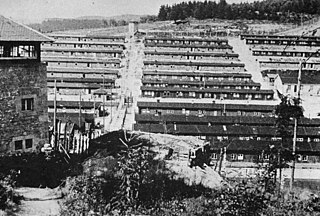
Flossenbürg was a Nazi concentration camp built in May 1938 by the SS Main Economic and Administrative Office. Unlike other concentration camps, it was located in a remote area, in the Fichtel Mountains of Bavaria, adjacent to the town of Flossenbürg and near the German border with Czechoslovakia. The camp's initial purpose was to exploit the forced labor of prisoners for the production of granite for Nazi architecture. In 1943, the bulk of prisoners switched to producing Messerschmitt Bf 109 fighter planes and other armaments for Germany's war effort. Although originally intended for "criminal" and "asocial" prisoners, after Germany's invasion of the Soviet Union, the camp's numbers swelled with political prisoners from outside Germany. It also developed an extensive subcamp system that eventually outgrew the main camp.
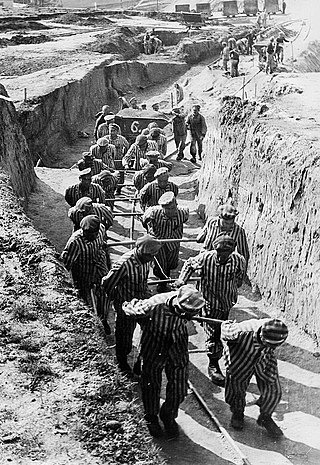
From 1933 to 1945, Nazi Germany operated more than a thousand concentration camps, including subcamps on its own territory and in parts of German-occupied Europe.
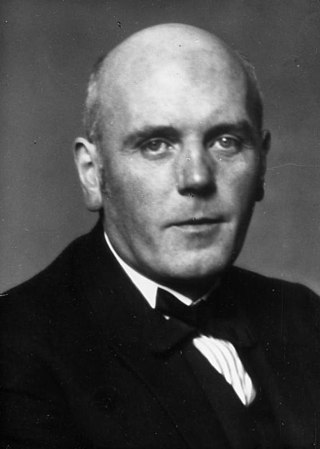
Paul Ludwig Troost was a German architect. A favourite master builder of Adolf Hitler from 1930, his Neoclassical designs for the Führerbau, the Verwaltungsbau der NSDAP and the Haus der Kunst in Munich influenced the style of Nazi architecture.
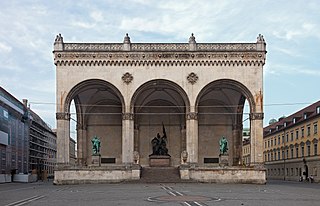
The Feldherrnhalle is a monumental loggia on the Odeonsplatz in Munich, Germany. Modelled after the Loggia dei Lanzi in Florence, it was commissioned in 1841 by King Ludwig I of Bavaria to honour the tradition of the Bavarian Army.
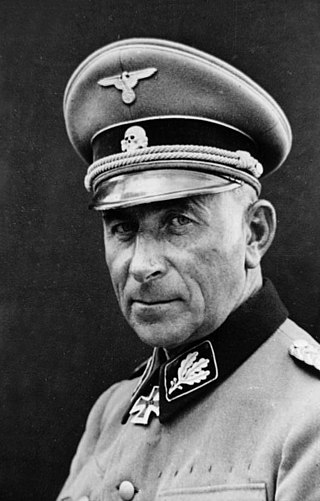
Paul Hausser also known as Paul Falk after taking his birth name post war was a German general and then a high-ranking commander in the Waffen-SS who played a key role in the post-war efforts by former members of the Waffen-SS to achieve historical and legal rehabilitation.

Königsplatz is a square in Munich, Germany. Built in the style of European Neoclassicism in the 19th century, it displays the Propyläen Gate and, facing each other, the Glyptothek and the Staatliche Antikensammlungen. The area around Königsplatz is home to the Kunstareal, Munich's gallery and museum quarter.
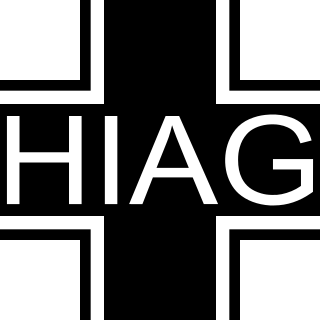
HIAG was a lobby group and a denialist veterans' organisation founded by former high-ranking Waffen-SS personnel in West Germany in 1951. Its main objective was to achieve legal, economic, and historical rehabilitation of the Waffen-SS.
Gavriel David Rosenfeld is President of the Center for Jewish History in New York City and Professor of History at Fairfield University. His areas of academic specialization include the history of Nazi Germany, memory studies, and counterfactual history. He is an editor of The Journal of Holocaust Research and edits the blog, The Counterfactual History Review, which features news, analysis, and commentary from the world of counterfactual and alternate history.

The Holocaust in Ukraine was the systematic mass murder of Jews in the Reichskommissariat Ukraine, the General Government, the Crimean General Government and some areas which were located to the East of Reichskommissariat Ukraine, in the Transnistria Governorate and Bessarabia, Northern Bukovina and the Hertsa region and Carpathian Ruthenia during World War II. The listed areas are currently parts of Ukraine.

Deutsche Wirtschaftsbetriebe, abbreviated DWB, was a project launched by Nazi Germany in World War II. Organised and managed by the Allgemeine SS, its aim was to profit from the use of slave labour extracted from the Nazi concentration camp inmates.

Georg Bachmayer was an SS-Hauptsturmführer (captain) and member of the SS-Totenkopfverbände who served as the Schutzhaftlagerführer, with responsibility for prisoners while they were inside the Mauthausen concentration camp, he also oversaw granite production in the quarry. In this position he also inspected the satellite camps and supervised the construction of the Ebensee camp. He was considered a brutal sadist.
Egon Gustav Adolf Zill was a German Schutzstaffel (SS) Sturmbannführer and concentration camp commandant.

In Nazi Germany, women were subject to doctrines of Nazism by the Nazi Party (NSDAP), which promoted exclusion of women from the political and academic life of Germany as well as its executive body and executive committees. On the other hand, whether through sheer numbers, lack of local organization, or both, many German women did indeed become Nazi Party members. In spite of this, the Nazi regime officially encouraged and pressured women to fill the roles of mother and wife only. Women were excluded from all other positions of responsibility, including political and academic spheres.

This is a list of books about Nazi Germany, the state that existed in Germany during the period from 1933 to 1945, when its government was controlled by Adolf Hitler and his National Socialist German Workers' Party. It also includes some important works on the development of Nazi imperial ideology, totalitarianism, German society during the era, the formation of anti-Semitic racial policies, the post-war ramifications of Nazism, along with various conceptual interpretations of the Third Reich.

Stripped Classicism is primarily a 20th-century classicist architectural style stripped of most or all ornamentation, frequently employed by governments while designing official buildings. It was adopted by both totalitarian and democratic regimes. The style embraces a "simplified but recognizable" classicism in its overall massing and scale while eliminating traditional decorative detailing. The orders of architecture are only hinted at or are indirectly implicated in the form and structure.

Süddeutsche Monatshefte was a German magazine published in Munich between January 1904 and September 1936. After beginnings as an art and literary venue, liberal but highly critical of modernism, it made a turn toward politics before World War I. Especially supportive of German conservatism, it was also sympathetic toward Völkisch ideologists, and published propaganda in favor of militarist politicians such as Alfred von Tirpitz. Having for its founder and editor Paul Nikolaus Cossmann, an assimilated Jew, Süddeutsche Monatshefte was generally antisemitic—strongly so after 1920, when it hosted calls for racial segregation.

Nazi architecture is the architecture promoted by Adolf Hitler and the Nazi regime from 1933 until its fall in 1945, connected with urban planning in Nazi Germany. It is characterized by three forms: a stripped neoclassicism, typified by the designs of Albert Speer; a vernacular style that drew inspiration from traditional rural architecture, especially alpine; and a utilitarian style followed for major infrastructure projects and industrial or military complexes. Nazi ideology took a pluralist attitude to architecture; however, Hitler himself believed that form follows function and wrote against "stupid imitations of the past".
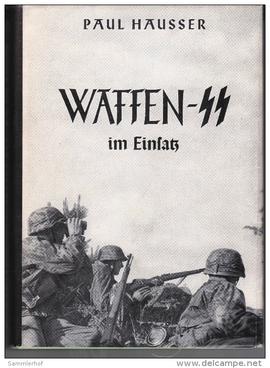
Waffen-SS im Einsatz is a 1953 book in German by Paul Hausser, a former high-ranking SS commander and a leader of the Waffen-SS lobby group HIAG. As part of the organisation's historical-negationist agenda, it advanced the idea of the purely military role of the Waffen-SS.

Forced labor was an important and ubiquitous aspect of the Nazi concentration camps which operated in Nazi Germany and German-occupied Europe between 1933 and 1945. It was the harshest and most inhumane part of a larger system of forced labor in Nazi Germany.